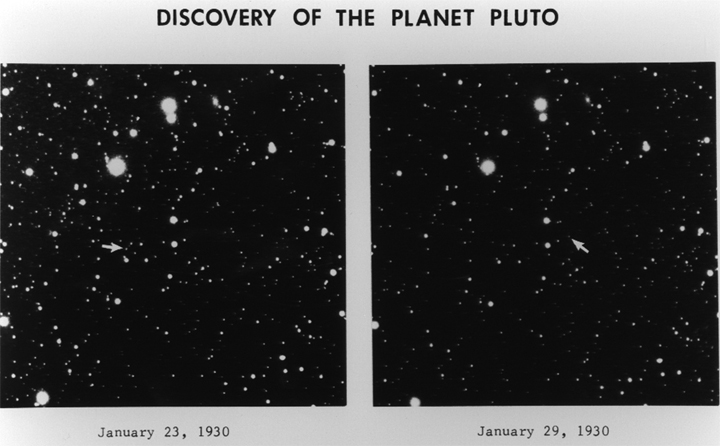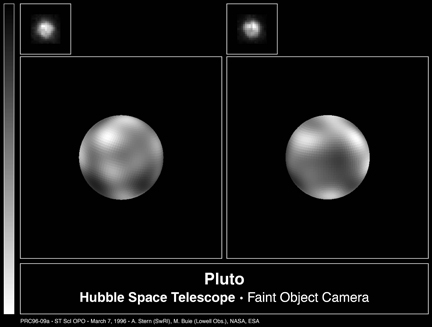Pluto
Overview
Pluto, formerly the ninth planet, formerly a dwarf planet of three, and now a "plutoid." As such, it is perhaps best characterized by its history in astronomical and popular culture.
History
After Uranus was discovered, tiny changes in its observed orbit could not be accounted for by the gravitational effects of the other planets. The end result was that another planet was theorized to exist, and it was discovered to be Neptune. Additional perturbations were then found to Neptune's orbit in 1905, and this created the idea that there should be an additional planet beyond Neptune.
Many searches were conducted, but the "missing planet" was not found. But in 1930, Clyde Tombaugh discovered what appeared to be the key, and the body was confirmed to be a large object beyond Neptune's orbit, and it was granted planetary status and named Pluto (see discovery plates below). At the time, it didn't matter that this planet was in the "wrong" place to account for the perturbations, and it was later determined that the differences in Neptune's orbit could be accounted for by other things.
 |
| Two photographs of the night sky, taken one week apart. The arrow points to a small dot that moved during that time, which led Clyde Tombaugh to discover the object that became known as Pluto. Figure is from the Planetary Society, but originally from the Lowell Observatory archives. |
Because of its huge distance from the Sun (at that time it was beyond Neptune's orbit), very little could be discerned about the distant world. Some believed it was larger than Earth, and some thought it was as large as Neptune or Uranus. Its orbit was worked out and it was discovered that it was highly elliptical, like a comet. But it was by far the biggest comet anyone had ever encountered, so its planetary status was not questioned. Its eccentric orbit takes it inside of Neptune's by less than 8 million km (5 million miles) but as far out as 160% as far as Neptune is from the Sun.
Most recently, Pluto crossed Neptune's orbit in 1999 and was the farthest planet from the Sun (until it was re-classified). Pluto and Neptune, however, will never collide. For every 3 years on Neptune, Pluto has 2 years, and this resonance will prevent them from ever hitting each other.
In 1978, the discovery of the moon Charon was announced by Captain J.C. Smith of the U.S. Naval Observatory, where it was discovered by James W. Christy. It was soon determined that twice in the 248-year orbit of Pluto, Charon transits, or crosses in front of Pluto, as seen from Earth. By a lucky chance, one set of transits occurred between 1985-1990. If Charon has been discovered just a few years later, we would have to wait until 2109 before we could see this.
When Charon crosses in front of Pluto, and when Pluto passes in front of Charon, the total amount of light that we receive from the system dims. The amount of dimming depends upon exactly which part of the planet or moon is blocked from Earth's view. By making many observations throughout the set of transits, a map of the reflectivity of the planet and moon could be built up. These are the best maps we have of these two objects.
Status
The information above presents the case that, at the very least, Pluto was an odd planet that has many characteristics of a planet. It was discovered at a time when people were looking for another planet in that region of space, and when they were not looking for a large belt of cometary objects, as we are now (see the discussion of the Kuiper Belt). In recent years, giant objects several hundreds of kilometers have been discovered in the same region of space as Pluto. In the Summer of 2005, it was announced that an object 25% larger than Pluto was discovered, which has since been named "Eris."
If Pluto were discovered today, there is no doubt that it would be considered a Kuiper Belt Object and not a planet. However, historically and popularly, Pluto is a planet. When the director of the Rose planetarium in New York did not have a display for it in its planets area, there was a public outcry ... though the outcry only happened a year after the display was built, when the New York Times ran a story about it.
Because of the changing nature of our understanding of the outer solar system, the International Astronomical Union (IAU) formed a committee that worked for about two years to study what the definition of a planet "should" be in scientific terms. They presented their recommendations at the August 2006 meeting of the IAU in Prague. Their recommendations were not greeted with much favor - in part because it seemed as if the definition had been construed to keep Pluto a planet - and subsequent changes were made and ratified. This created a new class of planets called "Dwarf Planets," of which Pluto was now a member. For more information on what qualifies as a dwarf planet, see the main page on Dwarf Planets.
Being a dwarf planet now, Pluto received a minor planet number, 134340 (IAUC 2006).
Surface
 |
| Brightness map of Pluto, as imaged by the Hubble Space Telescope. Image courtesy of NASA. |
Spectroscopy can be used to determine a rough composition of Pluto. It appears to be made up of a rock and ice mixture. At the poles are frozen methane. Also, methane and nitrogen snow fall there. Near the equator, the ground is a reddish color, and no snow falls there.
That is near the limit of what we can tell about Pluto. It is so far away that even the Hubble Space Telescope (HST) can tell us very little. HST is one of the few telescopes that can separate the images of Pluto and its moons, Charon, Nix, and Hydra.
Atmosphere
Pluto has an envelope of gas that surrounds it that grows as it approaches the sun and shrinks as it moves farther away, just as a comet's coma does. This is what is referred to as its "atmosphere."
Pluto's atmosphere exerts a tiny pressure of approximately 3 μbar on the surface. Its scale height is 60 km, meaning that it is very spread out and tenuous; its composition consists of methane (CH4) and nitrogen (N2).
Exploration
The following is a list of the missions that have finished, are currently in operation, or are planned to be launched to explore asteroids. A brief summary is displayed, but you can click on the name of the mission to be taken to a page detailing the mission.
New Horizons ~ 2007-2015+ ~ Launched in 2007, the New Horizons craft is currently en route to its Pluto encounter, scheduled for 2015.
Name Mythology
Pluto is named after the ancient Roman god of the underworld, which is a fitting name for a planet that lies so far from the warm Sun, receiving only 1/16,000 of the light we receive on Earth. It was not named after the Disney-created dog -- rather, the dog was named for the planet. Additionally, the name "Pluto" was chosen so that the first two letters, "P" and "L," in order to honor its discoverer, Percival Lowell.
Pluto's largest moon, Charon, is named after the figure who ferried dead souls across the river Styx into the underworld.
The two smaller moons have been named Hydra and Nix. The moon Nix would have been named "Nyx," but that name is taken by asteroid 3908, so the Egyptian equivalent was chosen. Nix is the goddess of darkness and night, and she was the mother of Charon. Hydra was the monster from Greek mythology that had the body of a serpent and nine heads. Additionally, the names were chosen to honor the New Horizons craft (so they begin with "N" and "H") that is currently en route to Pluto, and also to honor the Hubble Space Telescope (Hydra beginning with "H"), which was used to verify the moons' existence.
Since no craft nor telescope has ever seen features on Pluto, a naming convention for them has not yet been assigned.
Data
The following table lists data for Pluto and the other dwarf planets for comparison purposes. Data is compiled from NASA's planetary factsheet for Pluto, and from primary sources for the other dwarf planets; see the individual pages on the dwarf planets for references.
| Ceres | Pluto | Haumea | Makemake | Eris | |
|---|---|---|---|---|---|
| Perihelion (109 km) | 0.381 | 4.436 | 5.260 | 5.761 | 5.65 |
| Semi-Major Axis (106 km) | 0.415 | 5.906 | 6.484 | 6.850 | 10.12 |
| Aphelion (106 km) | 0.449 | 7.376 | 7.708 | 7.940 | 14.60 |
| Average Orbital Velocity (km/s) | 10.587° | 17.16° | 4.484 | 4.419 | 3.436 |
| Orbital Inclination (from Earth's Orbit) | 10.587° | 17.16° | 28.19° | 28.96° | 44.187° |
| Orbital Eccentricity | 0.080 | 0.2488 | 0.18874 | 0.159 | 0.44177 |
| Equatorial Radius (km) | 975 | 1195 | ~996 x 1518 x 1960 | ~2000 | 1300+200−100 |
| Polar Radius (km) | 909 | 1195 | ~2000 | 1300+200−100 | |
| Mass (1021 kg) | 0.95 | 12.5 | 4.2±0.1 | ~40 | 16.7±0.2 |
| Density (water=1 g/cm3) | 2.08 | 1.75 | 2.6-3.3 | ~2 | 2.3±0.3 |
| Sidereal Rotation Period (hours) | 9.074 | 153.2820 | 3.915 | ? | ~25.9 |
| Sidereal Orbital Period (days) | 1679.819 | 90,588 | 104,234 | 113,183 | 203,600 |
| Apparent Magnitude | +6.7 to +9.3 | +15.1 | +16.7 | +17.3 | +18.7 |
| Absolute Magnitude | +3.36±0.02 | -0.7 | -0.48 | +0.17 | -1.15 |
| Number of Moons | 0 | 3 | 2 | 0 | 1 |
| Discoverer | G. Piazzi | C. Tombaugh | M.E. Brown, C.A. Trujillo, & D.L. Rabinowitz | M.E. Brown, C.A. Trujillo, & D.L. Rabinowitz | M.E. Brown, C.A. Trujillo, & D.L. Rabinowitz |
| Discovery Date | Jan. 1, 1801 | Feb. 18, 1930 | Dec. 28, 2004 | Mar. 31, 2005 | Oct. 21, 2003 |